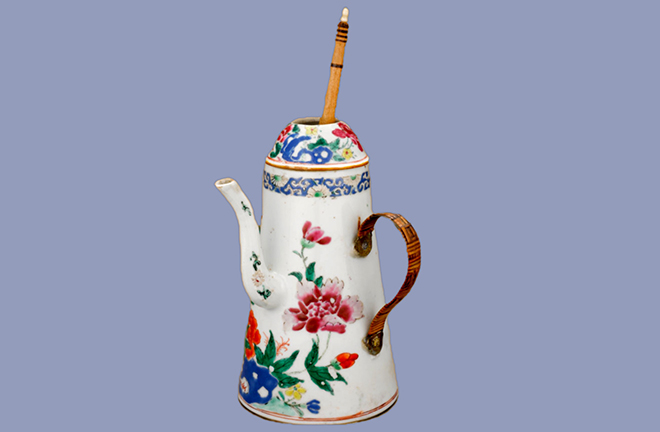Manila Galleon shipping Chinese fashion to Mexico

FILE PHOTO: A Chinese porcelain pot made in Jingdezhen in the late 18th century, used as a chocolate pot in Mexico
On July 1, 1573, two large galleons laden with Chinese goods set sail from Manila in the Philippines, heading for Acapulco on the coast of Mexico, thus inaugurating the Manila Galleon Trade. Each year, 1 to 4 galleons departed from Manila to Mexico, each carrying between 300 to 1000 tons of cargo, with some even reaching 2000 tons. The galleons primarily transported Chinese goods, and in exchange, a substantial amount of silver from Mexico and even Peru was shipped back to China. It is estimated that 20% of the silver mined in New Spain was used to purchase Asian goods. Throughout the entire galleon trade period, the amount of Latin American silver flowing into China reached 100 million pesos.
Chinese silk was a major commodity transported by the Manila galleons, with each galleon usually carrying an estimated 100,000 bolts of silk, sometimes as many as 400,000, with a value generally ranging from 2 to 4 million pesos. By the late 18th century, Chinese silk and other goods accounted for 63% of Mexico’s total imports. According to Spanish scholar José Luis García-Thomas, between 1600 and 1640, Chinese silk made up 99% of all textiles imported from Asia into New Spain, including 39% raw silk, 59% silk fabrics, and 1% finished garments.
Chinese silk and its products played a significant role in the attire of Mexico’s elite. Through the analysis of 128 estate inventories in Mexico City from 1580 to 1630, García-Thomas found that Chinese raw silk and silk fabrics were prominently listed, with 39.8% of the inventories mentioning at least one garment made from Chinese silk, averaging 4.3 Chinese silk garments per inventory. These inventories often specifically mentioned “from China” when referring to silk. Chinese silk was widely used for luxury item production in New Spain. The clothing and bedding of the wealthiest families in Mexico City were predominantly crafted from Chinese raw silk. Traditional Spanish garments popular among the local upper classes were also woven from Chinese silk.
Chinese silk even left its mark on the fashion and tastes of the upper echelons of New Spain. In the 16th and 17th centuries, the elites of New Spain, influenced by European trends, primarily wore dark-colored clothing such as black, brown, and gray, reserving bright colors for special occasions and banquets. Chinese silk, frequently dyed in vibrant blue, green, red, and yellow tones, grew highly coveted, challenging the dominance of dark colors in elite fashion to some extent. The decorative patterns of Chinese silk also influenced the clothing of Mexico’s upper classes. Traditional Chinese embroidered floral motifs like lotus and chrysanthemum were commonly seen on luxurious fabrics such as brocade and velvet, favored by the New Spain elites.
Porcelain ranked as the second most sought-after oriental commodity in the galleon trade behind silk. Works of Chinese porcelain became prized collectibles among the affluent residents of New Spain. In this region, porcelain was primarily cherished as an artistic treasure, symbolizing wealth and cultural refinement. García-Thomas’s research on the estate inventories from Mexico City reveals that nearly 24.2% of the inventories included porcelain, with an average of 13 porcelain items per inventory, underscoring its significance as a family heirloom. Porcelain was also used in dowries. For example, a dowry letter from a Colima resident written in 1614 mentioned “one large porcelain piece from China.”
Chinese blue and white porcelain was highly prized in the manors and Catholic sanctuaries of New Spain. The existing museum collections and archaeological discoveries in Mexico reveal that most of the porcelain transported to New Spain by the Manila galleons from the late 16th to early 17th centuries came from Jingdezhen [China’s porcelain hub]. Chinese porcelain found in Mexico spans from the reign of the Wanli Emperor of the Ming Dynasty to the reign of the Qianlong Emperor (r. 1736–1796) of the Qing Dynasty. Archaeological excavations at the San Jerónimo Convent in Mexico City between 1976 and 1981 unearthed approximately 123 kilograms of oriental porcelain, nearly 56% of which had been produced in the Wanli era, 20% dated to the late Ming and early Qing periods, and 15% from the reign of the Kangxi Emperor (r. 1662–1722). The findings also indicate that religious sites in New Spain were major users of Chinese porcelain. Large quantities of porcelain fragments have been unearthed in churches and convents in Puebla, Oaxaca, and Hidalgo, suggesting that religious communities had easier access to Chinese porcelain, and sufficient wealth to purchase it.
During Spanish colonial rule over Mexico, New Spain hosted a network of distributors and freight forwarders for oriental goods. Chinese products were distributed from Mexico to Spain, Peru, Guatemala, Cuba, and other places, promoting the “Chinoiserie” trend in 17th and 18th-century Europe.
Yuan Yan is an associate professor from the Southwest Medical University.
Edited by REN GUANHONG

 PRINT
PRINT CLOSE
CLOSE